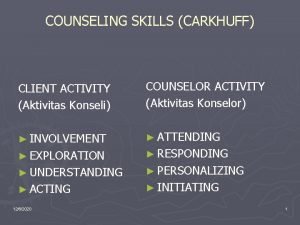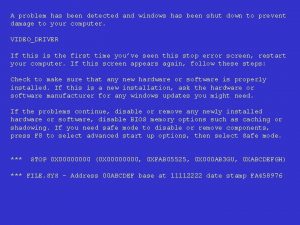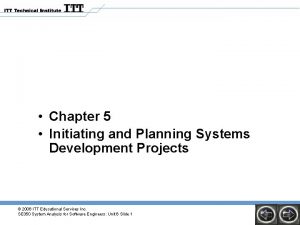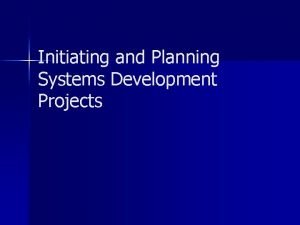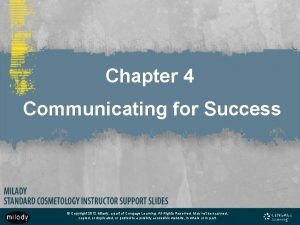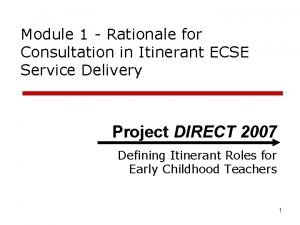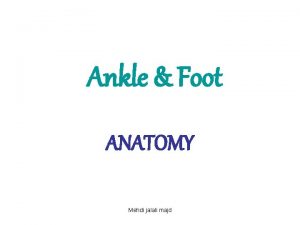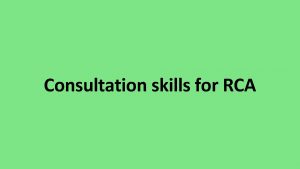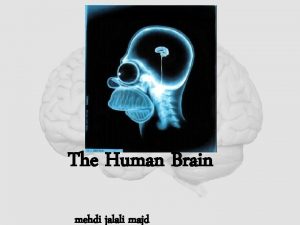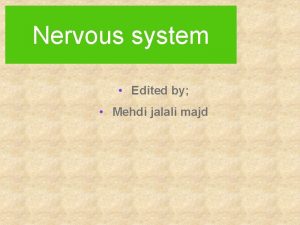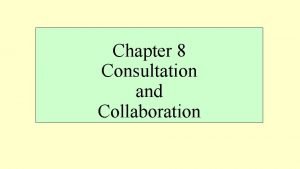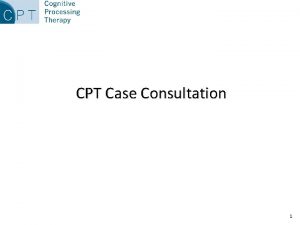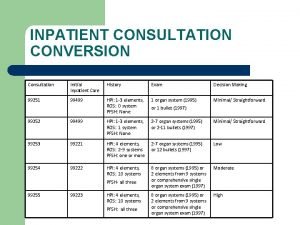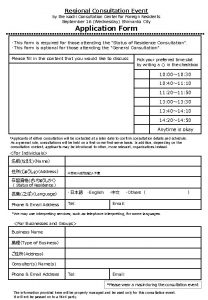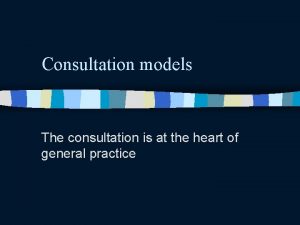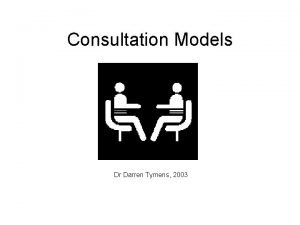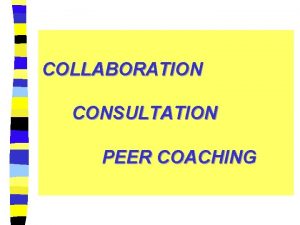CONSULTATION SKILLS Dr Ekram A Jalali INITIATING THE

























- Slides: 25

CONSULTATION SKILLS Dr. Ekram A Jalali

INITIATING THE CONSULTATION OBJECTIVES n Establishing a supportive environment n Developing an awareness of the patient’s emotional state n Identifying as far as possible all the problems or issues that the patient has come to discuss n Establishing an agreed agenda or plan for the consultation n Enabling the patient to become part of a collaborative process

SKILLS Preparation • Puts aside last task, attends to self comfort • Focuses attention and prepares for this consultation Establishing initial rapport • Greets patient and obtains patient’s name • Introduces self and clarifies role • Attends to patient’s physical comfort, demonstrates interest and respect

Identifying the reason(s) for the patient’s attendance • Opening ended question: identifies the problems or issues that the patient wishes to address (e. g. “What would you like to discuss today? ”) • Listening to the patient attentively without interrupting or directing patient’s response

Identifying the reason(s) for the patient’s attendance Checking list of problems or issues that the patient wishes to cover (e. g. “so that’s headaches and tiredness, is there anything else you’d like to discuss today as well? ”) • Agenda setting: negotiates agenda and format of interview taking both patient’s and physician’s needs into account n

INFORMATION GIVING, EXPLANATION AND PLANNING n n n Gauging the correct amount and type of information to give to each individual patient Providing explanations that the patient can remember and understand Providing explanations that relate to the patient’s illness framework

INFORMATION GIVING, EXPLANATION AND PLANNING n n n Using an interactive approach to ensure a shared understanding of the problem with the patient Involving the patient and planning collaboratively to increase the patient’s commitment and adherence to plans made Continuing to build a relationship and provide a supportive environment

Pendleton 7 Tasks n n n n To define the real reasons for pt attendance To consider other problems To choose with the pt. appropriate action for each problem To achieve a share understanding To involve pt. in the management To use time & resources effectively To establish & maintain Dr. -pt. relationship

Pendleton 7 Tasks n To Explore the Real Reasons for Pt. Attendance n n n n History Nature of the problem Etiology Effect of the problem Ideas Concern Expectation Fears

Pendleton 7 Tasks n Skills Needed To Explore the Real Reasons for Pt. Attendance n n n n n Open ended questions Indirect questions Use of silence Recognition of patient’s cues Immediate response to patient’s cues Confrontation Reflection Probing Summarization

Pendleton 7 Tasks Practicing Consultation Skills n Establishing & maintaining Dr- Pt Relationship n n n n n Prior to consultation Welcoming the patient Initiating the interview Showing interest Balance between intimate relationship & professional relationship Maintaining the relationship Showing empathy Legitimation Showing support

Practicing Consultation Skills Ethical Considerations n n n Respecting patient autonomy Confidentiality Non judgmental attitude

Diagnosis in PHC n n n Pattern of recognition Hypothetical deductive reasoning method Using clinical epidemiology Living with uncertainty 50% No diagnosis

Diagnosis in PHC n Hypothetical Deductive Reasoning Method n n n n n Present Complain + Context of the consultation + Previous knowledge about the patient. + Verbal & non verbal cues 3 -5 Hypotheses (Dr. clinical + epidemiological knowledge + Dr. experience) Inclusion or exclusion of hypotheses (Dr. conducting verbal examination or physical examination or selective investigations

Management Skills n n n Negotiation skills Reassurance skills Health Education Counseling Prescribing Investigations Referral Follow up Modification of help seeking behavior Use of medical records House keeping

Difficult Consultation n Different Patients Need Different Consultation Skills n n n Patient Reluctant to Talk Freely Angry Patient Demanding Patient Talkative Patient Poor Compliance

Difficult Consultation n Patient Reluctant to Talk Freely n Causes : n n Patient Factors Dr. Factors Circumstances Examples : The topic Cultural barrier Social class barrier Dr. authority Time constrains Presence of 3 rd party

Difficult Consultation n n Approach to Patient Reluctant to Talk Freely Verbal Communication n n n Giving reason for the question. Comments on the patient attitude Generalization of the problem Asking at the right time Reflection Mirroring Confrontation

Difficult Consultation n n Approach to Patient Reluctant to Talk Freely Non - verbal Communication. n n n Showing sympathy & empathy Showing real interest Unhurried manner Touch for reassurance Use of physical examination

Difficult Consultation n Angry Patient Communication Skills n n n Empathy Legitimation Non-judgmental attitude Respect patient autonomy Support Flexibility

Difficult Consultation n Demanding Patient communication Skills n n n Discuss the effect of the problem in the patient life Focus on immediate concern Deal with feelings

Difficult Consultation Demanding Patient communication Skills n n Comment on the process of the interview Negotiate agenda & goals : 1. Set limit 2. Reinforcement 3. Compromise & Be flexible n Focus on patient as well as his demands & complaints

Difficult Consultation Talkative Patient n Summarization n Prioritization n Use of touch n Sympathy & empathy

Behaviors which brake the relationship n Interruption n Close ended question

Thank You
 Leila jalali
Leila jalali Consultation skills for pharmacy practice
Consultation skills for pharmacy practice Www.consultationskillsforpharmacy.com
Www.consultationskillsforpharmacy.com Consultation skills for pharmacy practice
Consultation skills for pharmacy practice Circumscribing stage
Circumscribing stage Initiating process group
Initiating process group Bcf model conflict resolution
Bcf model conflict resolution Attending responding personalizing initiating
Attending responding personalizing initiating A problem has been detected and windows
A problem has been detected and windows Initiating and planning systems development projects
Initiating and planning systems development projects Initiating and planning systems development projects
Initiating and planning systems development projects A problem has been detected and windows xp
A problem has been detected and windows xp Requirement validation in software engineering
Requirement validation in software engineering Leadership challenges for the youth of today
Leadership challenges for the youth of today Merchandise approach method
Merchandise approach method Ontario skills passport
Ontario skills passport How to develop intrapersonal skills
How to develop intrapersonal skills Hard skils
Hard skils Bradford vts consultation models
Bradford vts consultation models What are the golden rules of human relations?
What are the golden rules of human relations? Triadic consultation model
Triadic consultation model Stott and davis model
Stott and davis model Balint consultation model
Balint consultation model Stott davis model
Stott davis model Sdcc consultation portal
Sdcc consultation portal Deer oaks consultation services
Deer oaks consultation services







